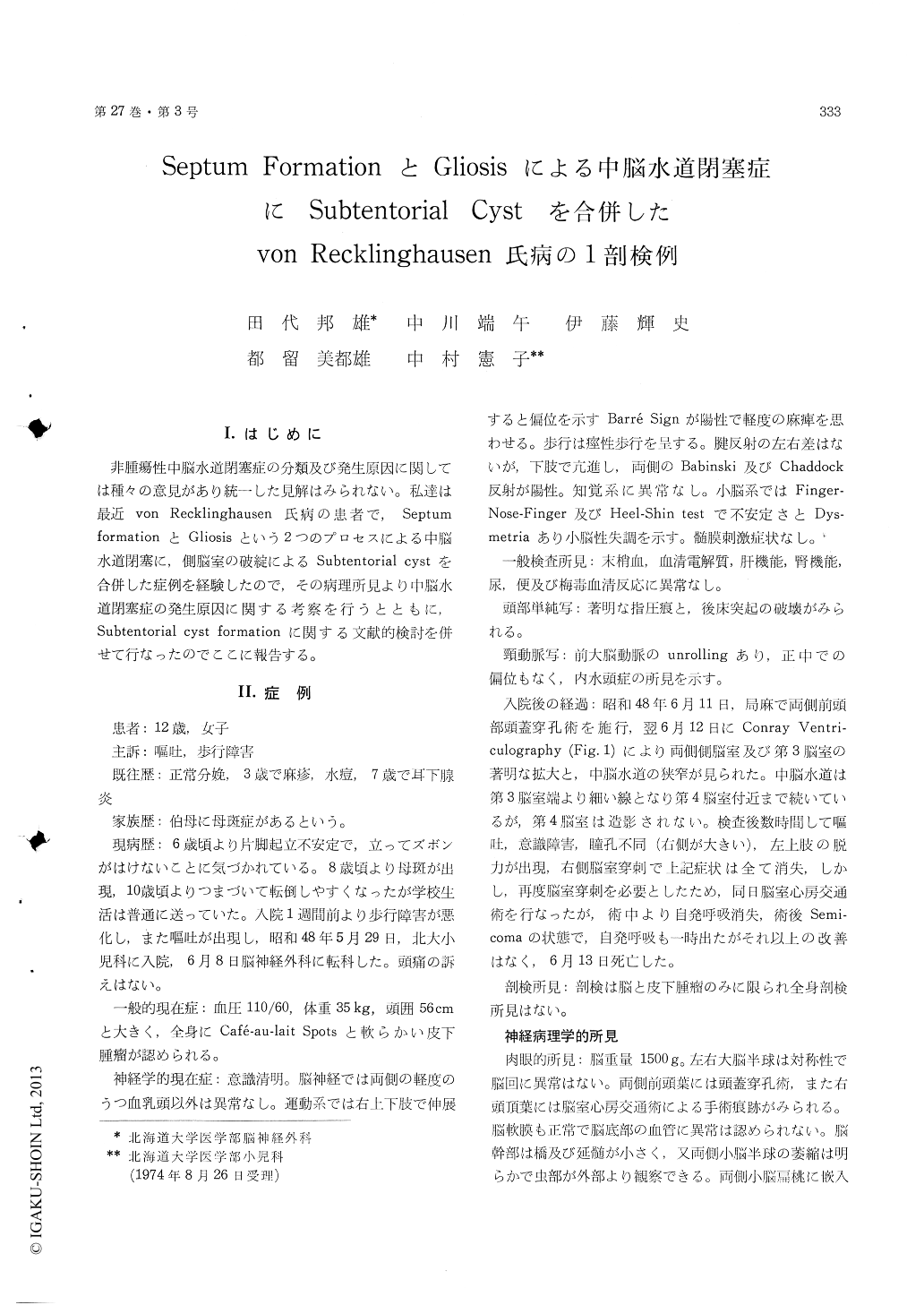Japanese
English
- 有料閲覧
- Abstract 文献概要
- 1ページ目 Look Inside
I.はじめに
非腫瘍性中脳水道閉塞症の分類及び発生原因に関しては種々の意見があり統一した見解はみられない。私達は最近von Recklinghausen氏病の患者で,SeptumformationとGliosisという2つのプロセスによる中脳水道閉塞に,側脳室の破綻によるSubtentorial cystを合併した症例を経験したので,その病理所見より中脳水道閉塞症の発生原因に関する考察を行うとともに,Subtentorial cyst formationに関する文献的検討を併せて行なったのでここに報告する。
This is the first pathologically documented caseof aqueductal occlusion due to both septum formation and gliosis, associated with subtentorial cyst for-mation.
A 12 year old girl with history of unsteadiness on one-step standing since age 6, and stumbling on walking since 10, developed increasing difficulty in walking, and vomiting one week prior to admission to Hokkaido University Hospital. Neurological ex-amination revealed enlarged head, bilateral papil-ledema, spastic gait, hyperactive DTRs in both legs with positive Babinski and Chaddock reflexes, and cerebellar ataxia in 4 extremities. Multiple cafe-au-lait spots and subcutaneous nodules were seen all over the body. Plain skull films showed marked digital impressions and destruction of the posterior clinoid process. Carotid angiogram was compatible with the findings of internal hydrocephalus. Conray ventriculography (Fig.1) revealed slit-like aque-duct despite of markedly enlarged 3 rd ventricle. Following this examination, the patient became semicomatous, and expired.
Autopsy was limited to the brain and subcutane-ous nodules, the latter was neurofibroma micro-scopically. Sagital sections of the brain (Fig.2 A & B) disclosed irregular narrowing (Gliosis) at the level of superior colliculi, and membraneous oc-clusion (Septum formation) at the hind end of the aqueduct of Sylvius. A large thin-walled cyst was located at the subtetorial space, and communicated with left lateral ventricle (Subtentorial cyst for-mation). Microscopically the narrowing of the aqueduct was composed of subependymal gliosis, probably due to fusion of ependymal granulations (Fig.5). The septum was made up of fibrillary neuroglia with occasional ependymal cell linings (Fig.6).
Review of the literatures revealed 9 autopsy cases of septum formation of the aqueduct (Table 1), 8 autopsy proved cases of the aqueductal gliosis in von Recklinghausen's disease (Table 2), and 25 cases of subtentorial cyst formation (Table 4), in-cluding our case. The etiology of the aqueductal gliosis is still controversial ; some believes develop-mental, or inflammatory, others neoplastic. However the septum formation is generally believed to be developmental in origin The aqueduct of Sylvius in our case was occluded by septum formation and narrowed by gliosis without dilatation of the rest of the aqueduct, though the lateral ventricles and 3 rd ventricle were markedly dilated with rupture into the posterior fossa. It is proposed that the aqueductal gliosis was present prior to, or almost the same time as septum formation, suggesting the origin of the aqueductal gliosis developmental in our present case.

Copyright © 1975, Igaku-Shoin Ltd. All rights reserved.


